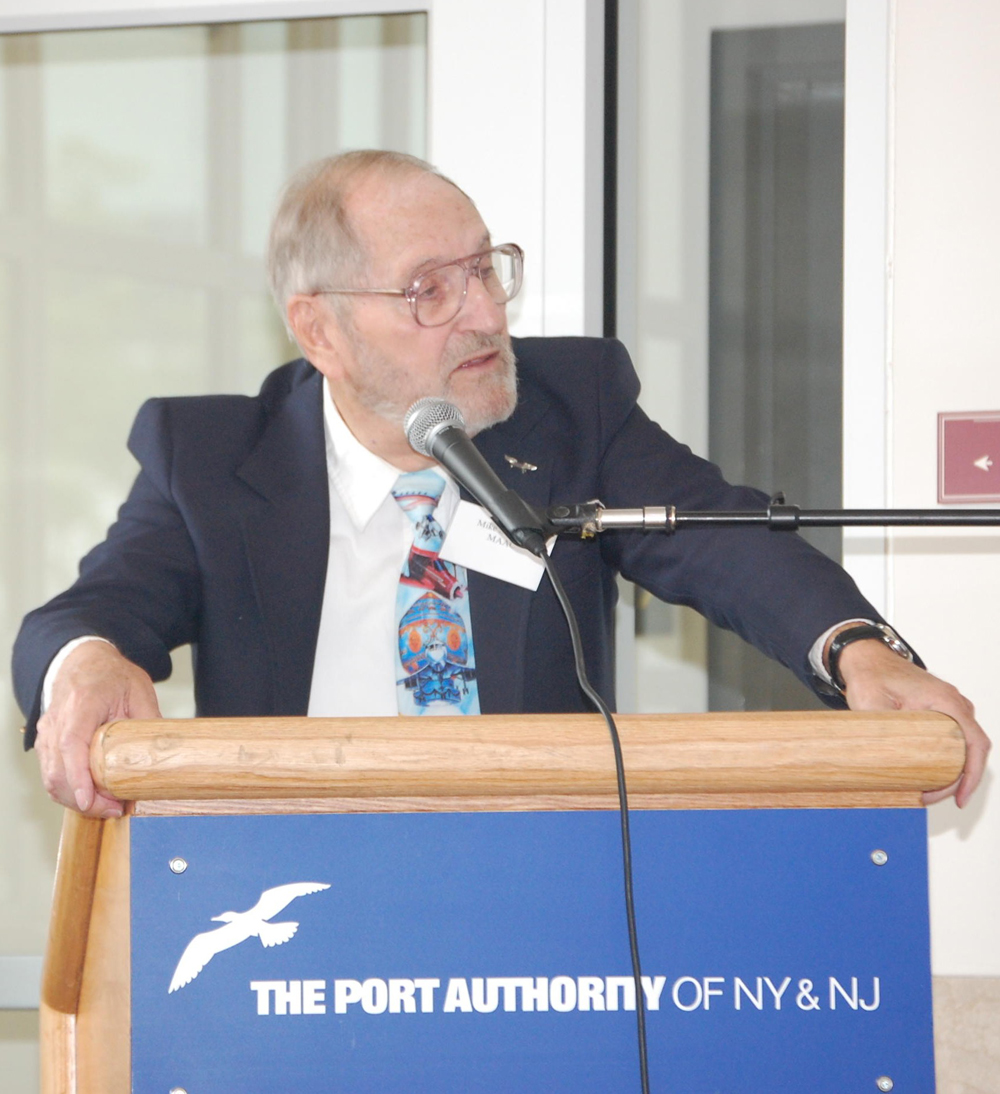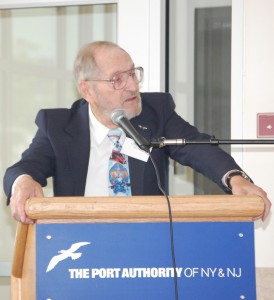
Mike Stoddard, president of the Mid-Atlantic Aviation Coalition – New Jersey, asked, “Where have all the airports gone?” He then reviewed the deteriorating number of airport closings in recent years.
By Henry M. Holden
In the past year, 15,000 New Jersey pilots, airport owners and others with strong interests in the state’s general aviation industry have watched two more airports close. Another may close before the year is over, and 11 more are vulnerable. Sixteen have closed permanently in the past 25 years, and a half-dozen of those still remain undeveloped. Hanover Airport (N58) closed in 1985; its runways are now weed-infested and crumbling. The township has been negotiating for years to purchase the airport, with plans to designate the area for “passive recreation.” At last count, 46 active GA airports remain.
Each year, representatives from all areas of New Jersey aviation meet to review important issues facing those involved in the state’s aviation industry. On May 2, the Mid-Atlantic Aviation Coalition presented the15th annual New Jersey Aviation Association Conference with “New Jersey’s Airports—An Endangered Species?” It outlined the causes, economic ramifications and possible solutions to the crisis facing the airports.
John Jacoby, general manager of Newark’s Liberty International Airport (EWR) sees GA as a bird metaphor.
“What bird represents GA?” Jacoby asked. “Is it the extinct dodo? Perhaps once it flew, but the forces of evolution clipped its wings, grounding it forever. This is one possible outcome for New Jersey’s GA, unless we do something.
“Perhaps the bird is the efficient albatross. Unfortunately, we know from Coleridge’s poem, ‘The Ancient Mariner,’ that the albatross is often something you hang around your neck when you’re in trouble. Many people in this state see general aviation as a burden to the system.
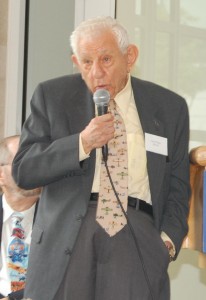
Journalist Jack Elliott, who has reported on New Jersey aviation for more than 30 years, has seen the decline in GA airports. He suggests more people get involved in the fight to save the remaining airports.
“GA should be seen as the bald eagle. The bald eagle was once on the endangered species list, but is no longer. It’s our task to remove the danger to our GA airports. GA is the habitat of aviation’s past development and is a key factor in our future growth. Once, GA and the economy stemmed from the local airports. It was, and continues to be, the feedstock of aviation. You’ll find that tomorrow’s airline pilots will come from general aviation. Those who go into the military to become pilots took an interest in flying at an early age. That interest was nurtured through GA.”
Causes of the crisis
Oversight of GA resides in the Bureau of Aeronautics, part of the New Jersey Department of Transportation. It is part of the Division of Intermodal Transit, where freight trains, port dredging, bicycle paths and roadside billboards take center stage.
Privately owned, public use airports are subject to private influences such as influential citizens and local governments. Municipalities usually decide which airport improvements are allowed. New Jersey has 566 municipalities, with multiple boards and commissions, all with the power to say yes or no. Some local governments have used eminent domain or blocked airport improvements to preserve open space, which airport owners say kills improvements required to ensure these airports survive and continue to serve the public.
Today, all airport owners must get permission from planning boards to construct new T-hangars.
The Department of Environmental Protection declares some streams on airport property as part of wetlands and thereby untouchable. Yet, downstream, many of these streams feed into polluted waterways.
People in surrounding communities fear the airports will grow, expanding noise and safety issues. Several airports have approach obstructions, usually trees, which the NJDOT is responsible for clearing but is slow taking down.
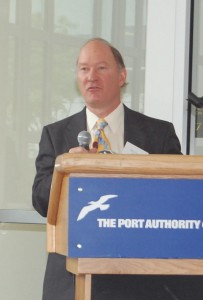
Bill Leavens, secretary of the Mid-Atlantic Aviation Coalition, raised safety issues and addressed his concerns that the New Jersey Department of Transportation wasn’t clearing runway obstructions in a timely manner.
Arlene Feldman, president of the New Jersey Aviation Association, expressed serious concerns that ignorance among elected officials may be the fatal blow.
“One top lawmaker asked me why we even need general aviation in the state,” she said. “He proceeded to tell me he wanted to close Teterboro, the 10th busiest GA airport in the country. I explained to him why that couldn’t happen. Teterboro supports 15,000 jobs and brings in $1.8 billion in annual sales to the economy. Then he asked me why we needed all the little airports, if all people do is fly out of one to have a Sunday morning breakfast. ‘So what if we closed one airport; they can just drive 10 miles to the next airport,’ he said.
“Another legislator implied that one of our busy GA airports is used to fly corporate executives to play golf in Hilton Head, S.C. It’s disturbing to know that many people think of GA as recreational flying by a few people who have the financial ability to do so. Obviously, we all have a big job ahead of us.”
Economic impact
About 70 percent of U.S. airline enplanements occur at about 35 hub locations. These airlines serve another 500 airports, while GA provides access to rural areas. More than 90 percent of the American population lives within 20 minutes of one of 5,500 airports nationwide.
GA provides links to commerce and society for all areas in the country. Jacoby says that connectivity needs to be preserved and protected.
“It’s not hard to imagine the nation’s economy without air transportation,” said Jacoby. “We just have to look back to Sept. 12, 2001. There was no aviation in this country, and the economy came to a screeching halt. Our nation needs GA, because it enhances the value and efficiency of our nation’s infrastructure.”
Who uses GA?

Tor Solberg, owner of Solberg Airport, suggested that paving the last 700 feet of his 3,700-foot runway would allow VLJs access, boosting the local economy.
Eighty-six percent of business aircraft passengers are marketing, sales and technical personnel, along with business customers. Only 14 percent of corporate jet passengers are managers.
“The closing of even one airport touches every aspect of our lives,” said Feldman. “It has a profound influence on the quality of life and the economy. Imagine what would happen if they closed Teterboro, a reliever airport for Newark. Teterboro handles about 200,000 takeoffs and landings a year.”
She also mentioned airfreight transport.
“Nobody thinks about the major impact that overnight packages and airfreight have on the economy,” she said. “UPS and FedEx use a lot of small airplanes. This is the message we have to get out; GA enhances the profitability and strength of U.S. business and industry. Some of that business strength will be lost when we lose airports, and our economy will suffer.
“Another aspect being overlooked is the advent of VLJs, which will bring economic development to wherever they land. Most GA airports in New Jersey can handle them without runway extensions. With the startup of the point-to-point air taxi, the trend should be reversing with GA airports becoming even more important to local economies.”
A lesson to learn

Attorney Arlene Feldman, president of New Jersey Aviation Association, had serious concerns over the lack of accurate information provided to New Jersey legislators. She sees a big job of educating lawmakers to the facts about general aviation.
GA proponents cite the recent closing of Atlantic City Municipal Airport/Bader Field (AIY) as an important lesson in the fight to keep remaining airports open. A Federal Aviation Administration grant assurance agreement gave Bader Field a 20-year life extension in 1986. The agreement came with a contractual obligation to operate the airport for 20 years or “in perpetuity,” if the grant was used to improve or buy land. Proponents say, “We now know perpetuity doesn’t mean forever in the courts.”
To some, the value of the land underneath an airport, especially an airport inside a downtown area, is greater than the airport itself.
AOPA’s proposed convention in Atlantic City in 2007 had hoped to send a message by parking 600 aircraft at AIY during the event. AOPA President Phil Boyer said, “The officials running the very underused Atlantic City International Airport simply didn’t want to be bothered with a bunch of GA aircraft, regardless of the income they would bring to the airport and the city. AOPA Expo would put such a ‘burden’ on their facilities that they wanted to charge us an exorbitant amount to pay for normal airport operations. That adds insult to the injury of years of neglect of Bader Field.”
Bader Field closed in late 2006.
“On the positive side, we’re making inroads and some progress,” said Feldman. “NJAA is now a member of the New Jersey Chamber of Commerce. We’re trying to get into every elected official’s office, on local, state and federal levels, to talk about the facts. We’re trying to work with DEP, and I believe we’re making progress. We have meetings coming up with the FAA, DEP and other associations, to try to come up with a process that will work for all of us.”
The pending loss of Solberg Airport
The pending loss of Solberg Airport, in Readington, may be the result of not seeking a grant assurance or pursuing an offer from NJDOT to purchase the airport’s development rights.
“Had the airport owners accepted federal grants for airport improvements, they would have enjoyed a 20-year period of freedom from any threat of condemnation,” said Bill Leavens, editor of the MAAC newsletter. “Now its future is bleak. With the advent of point-to-point air taxi operations, the world would come to Solberg, bringing dollars and jobs. If Solberg closes, the stage will be set for other public officials to use open space as a reason to close airports.”
Efforts are being made to get the federal government involved.

Linda Scully, one of only eight master certified flight instructors in New Jersey, receives a 2008 MAAC recognition award.
“The NJAA wrote letters to President Bush, Secretary of Transportation Mary Peters and a number of other high-ranking elected officials about Solberg Airport,” said Feldman. “The president’s office sent it down to the FAA, and I got a response. The point is, we didn’t think the president was going to do anything about it. If we can get a response from the White House, we should be able to get the legislators’ attention in Trenton. We’re encouraging legislators to meet with people from MAAC, the NJAA and anyone from the airports. We’d especially encourage dialogue with the legislators in whose areas these airports are located. We have to continue to get our message out to as many people as possible at all levels of government.”
Everyone in the aviation industry must work to promote, protect and preserve GA, she said.
“GA encompasses a broad section of interest from small, medium and large businesses, to government schools, foundations and the list goes on,” she continued. “Nationally, more than 10,000 companies use GA aircraft to help them compete in what has become a global market place. New Jersey is part of that global market. Eighty-five percent of those companies are small and mid-size companies that own and operate single aircraft.”
Solutions to the crisis
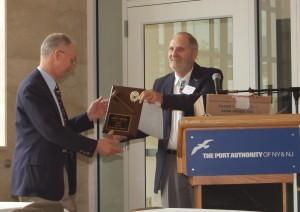
Bob Checchio, vice president of MAAC legislative affairs, received a recognition award from Mike Stoddard. The gavel is symbolic of Checchio’s leadership when he formerly served as MAAC president.
GA airports can relieve the crowded airspace surrounding such airports as Newark and Teterboro. They are valuable to law enforcement and medical evacuation and provide an opportunity for young people to pursue aviation careers.
“Grant assurance is the only way the FAA can come in and save the GA airport,” said Feldman. “We need state laws to prevent reclassification of airport lands to nonconforming land use, and these airports should not be burdened by additional regulations. We also need a unified federal policy that includes GA: one that communicates benefits of GA to surrounding communities. If we don’t speak with one voice on how important it is to the nation and the economy, only the other side will be heard.”
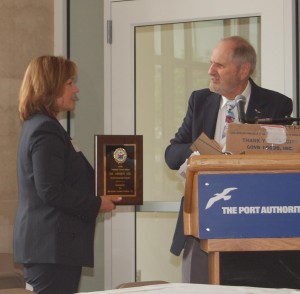
Maria Renner, security manager for Morristown Municipal Airport in Morristown, N.J, and member of the New Jersey Aviation Association Board of Directors, accepts a recognition award for NJAA’s numerous flight training scholarships.











